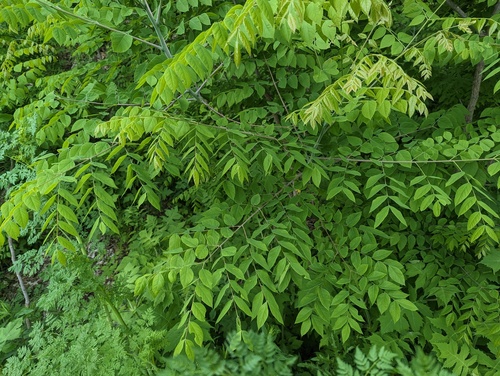Kentucky Coffee-tree

Species information
The following is a report on progress made towards the protection and recovery of Kentucky Coffee-tree (Gymnocladus dioicus) in Ontario from 2007 to 2022, based on Ontario’s species-specific recovery policy. This report meets the legislative requirement for a review of progress under the Endangered Species Act, 2007 (ESA or “the Act”). Kentucky Coffee-tree is listed as threatened on the Species at Risk in Ontario (SARO) List under the ESA.
Kentucky Coffee-tree has been classified as a species at risk since May 2000.It was originally classified as a threatened species and was listed as such under the ESA when it came into force in June 2008. In January 2023, the Kentucky Coffee-tree was reclassified as threatened in Elgin, Essex, Lambton, Middlesex, Norfolk and Oxford Counties and in the Municipality of Chatham-Kent, and was classified as not at risk in all other jurisdictions in Ontario.
Kentucky Coffee-tree has been protected from being killed, harmed, harassed, captured or taken since 2008.
In addition, the habitat of Kentucky Coffee-tree has been protected from being damaged or destroyed since 2013.
Currently, the species and its habitat are protected within its native Ontario range.
The species-specific recovery policy for Kentucky Coffee-tree, known as the Government Response Statement (GRS) was published in 2018 and includes the government’s recovery goal for the species and the actions and priorities it intends to lead or support to help achieve that goal. The GRS considers science advice provided in the recovery strategy (published in 2017), such as species biology, habitat needs, threats to survival, knowledge gaps and approaches to recovery, when developing recovery actions for the species. As legislated in the Act, the purpose of this review is to report on progress made towards implementing the protection and recovery actions in the GRS. The review can also help identify opportunities to adjust and adapt the implementation of protection and recovery actions to achieve the recovery goal for the species.
Further information about Kentucky Coffee-tree, including the threats that it faces, and actions being taken to help protect and recover this species is available on the Government of Ontario webpage for Kentucky Coffee-tree. A summary on the progress towards the protection and recovery of Kentucky Coffee-tree and an annual update on the broader species at risk program (i.e. the Introduction to the 2023 Review of Progress report) is available on the Review of Progress towards the Protection and Recovery of Ontario’s Species at Risk webpage.
Snapshot: Progress towards the protection and recovery of Kentucky Coffee-tree
Progress towards meeting the recovery goal
- The recovery goal in the Government Response Statement (GRS) for Kentucky Coffee-tree in Ontario is to “maintain the provincial distribution of the species within its natural range in Ontario and to enable increases in abundance by addressing barriers to reproduction. The government supports augmenting single-sex populations where feasible and investigating the necessity and feasibility of augmenting mixed-sex populations”.
- Progress has been made towards implementing all of the government-led actions. Progress has been made towards implementing all of the government-supported recovery objectives and some of the associated actions. Examples of progress include:
- Conducting inventory to determine population status and viability at historical and extant locations
- Evaluating the genetic variation and structure of North American Kentucky Coffee-trees
- Increasing awareness of Kentucky Coffee-tree among landowners and other citizens
- In alignment with the GRS, further work is required to assess single-sex populations to evaluate the feasibility of augmentation, develop and implement best management practices to conduct road and railway maintenance where Kentucky Coffee-tree is present, and manage water regimes and flood control in a manner that benefits the species (e.g., replicating natural flood cycles).
Occurrences and distribution:
- Kentucky Coffee-tree occurs in southwestern Ontario, with an estimated range of approximately 8,200 square kilometres based on recent observations.
- Since 2008, the Natural Heritage Information Centre (NHIC) has received 2,545 records of the species based on observations between 1891 and 2022.
- Since 2008, the species has been observed in 57 squares where it was not previously known to occur and at six squares previously thought to be historical.
- A recent assessment of the Kentucky Coffee-tree population has determined that the number of mature trees in Ontario is stable (COSSARO 2021).
Government-supported stewardship projects:
- Through the Species at Risk Stewardship Program, the Government of Ontario has enabled its stewardship partners to conduct nine projects (by providing $875,065 in funding) that have supported the protection and recovery of multiple species at risk, including Kentucky Coffee-tree. Eight of these projects were designed to provide benefits to multiple species at risk (e.g., landscape-level habitat restoration, or outreach and education focusing on a certain group of species such as those present in a local region), while one focussed exclusively on Kentucky Coffee-tree.
- The government’s support helped its stewardship partners to involve 796 individuals who volunteered 21,578 hours of their time towards protection and recovery activities for species at risk, including Kentucky Coffee-tree. The estimated value of these voluntary contributions, as well as additional funding and in-kind support, is $1,240,257.
- Stewardship partners reported that through their actions 84.3 hectares of habitat were enhanced for Kentucky Coffee-tree and other species at risk that inhabit the same ecosystem.
- Stewardship partners reported providing outreach on multiple species at risk, including Kentucky Coffee-tree, to 2,855 individuals.
Supporting human activities while ensuring appropriate support for species recovery:
- The Government of Ontario has issued 17 permits for this species: three ‘human health and safety’ permits were issued under clause 17(2)(a), nine ‘protection and recovery’ permits were issued under clause 17(2)(b), four ‘overall benefit’ permits were issued under clause 17(2)(c) and one ‘social or economic benefit’ permit was issued under clause 17(2)(d) of the ESA
- Fifteen agreements were entered into for Kentucky Coffee-tree. These agreements were enabled through Ontario Regulation 242/08 (prior to the July 1, 2013 amendment)
- Sixty-four activities have been registered for the species. The activities were registered under ‘threats to human health and safety, not imminent’ (section 23.18), ‘drainage works’ (section 23.9), ‘ecosystem protection’ (section 23.11), and ‘species protection, recovery activities’ (section 23.14) under Ontario Regulation 242/08 of the ESA
Reporting on the progress towards the protection and recovery of Kentucky Coffee-tree
Recovery Goal
The government’s goal for the recovery of Kentucky Coffee-tree is to maintain the provincial distribution of the species within its natural range in Ontario and to enable increases in abundance by addressing barriers to reproduction. The government supports augmenting single-sex populations where feasible and investigating the necessity and feasibility of augmenting mixed-sex populations.
The implementation of government-led and government-supported actions demonstrates progress towards reaching the desired objectives and the recovery goal set out in the GRS.
Progress towards implementing government-led actions
Progress has been made towards implementing all government-led actions identified in the GRS. Common actions for the government to lead as it works towards achieving a species’ recovery goal include:
- Continue to implement the Ontario Invasive Species Strategic Plan (2012) to address the invasive species (e.g., Dog Strangling Vine, Garlic Mustard) that threaten Kentucky Coffee-tree.
- Continue to implement Ontario’s Invasive Species Act to control the spread of invasive species (i.e., Dog Strangling Vine) that threaten Kentucky Coffee-tree by restricting the importation, deposition, release, breeding/growing, buying, selling, leasing or trading of Dog Strangling Vine.
- Educate other agencies and authorities involved in planning and environmental assessment processes on the protection requirements under the ESA.
- Encourage the submission of Kentucky Coffee-tree data to Ontario’s central repository through the citizen science projects that they receive data from (i.e., iNaturalist) and directly through the Natural Heritage Information Centre.
- Undertake communications and outreach to increase public awareness of species at risk in Ontario.
- Continue to protect Kentucky Coffee-tree and its habitat through the ESA.
- Support conservation, agency, municipal and industry partners, and Indigenous communities and organizations to undertake activities to protect and recover Kentucky Coffee-tree. Support will be provided where appropriate through funding, agreements, permits (including conditions) and/or advisory services.
- Encourage collaboration, and establish and communicate annual priority actions for government support in order to reduce duplication of efforts.
Additionally, the government has directly undertaken the following species-specific actions:
- Explore taking appropriate management actions in accordance with provincial policy direction on cormorants to support protection and recovery for Kentucky Coffee-tree.
- Continue to monitor and manage East Sister Island Provincial Park in a manner consistent with the park management plan; including monitoring of Kentucky Coffee-tree populations and potential threats (e.g., impact of Double-crested Cormorants) and determining whether specific management actions are necessary.
- Collaborate with federal partners, such as Parks Canada, Environment and Climate Change Canada, and Canadian Wildlife Service to implement protection and recovery actions for Kentucky Coffee-tree on federal lands, including Middle Island.
- For populations that occur on Pelee Island, explore opportunities to work collaboratively with the Township of Pelee, including the Pelee Island Environmental Advisory Committee, the federal government and local partners to integrate approaches to stewardship, implement recovery actions and explore integrated approaches to managing species at risk.
Ontario Parks continues to monitor and manage the Kentucky Coffee-tree population in East Sister Island Provincial Park to ensure population stability and growth. This includes analyzing potential threats of the Double-crested Cormorant (Phalacrocorax auratus) and determining if specific management actions are necessary. These management actions are based on the Ministry of Natural Resources and Forestry’s (MNRF) 2006 Provincial Cormorant Policy. This policy includes basic information on cormorants to assist in the management of the species and provide a basis for future development of management options.
The Government of Ontario also continues to take action to advance the management of invasive Dog-strangling Vine and Garlic Mustard by working with partners to identify innovative solutions to control these invasive plants. For example, MNRF has been supporting collaborative efforts with federal partners, the University of Toronto and the Invasive Species Centre to investigate potential biological control agents for both invasive Dog-strangling Vine and Garlic Mustard.
Key progress made towards implementing these actions is described in the following sections.
Ontario’s Invasive Species Act
The GRS for Kentucky Coffee-tree indicates that invasive species (e.g., Dog strangling Vine (Cynanchum rossicum), Black Dog-strangling Vine (Cynanchum louiseae) and Garlic Mustard (Alliaria petiolate)) pose a threat to the survival and recovery of the species in Ontario. The Ontario Invasive Species Strategic Plan, 2012 and the Invasive Species Act, 2015 provide the policy and legislative framework to prevent new invaders from arriving and surviving in Ontario, to slow and where possible reverse the spread of existing invasive species, and to reduce the harmful impacts of existing invasive species, including impacts on species at risk.
This framework may support the implementation of actions to reduce the threats from invasive species. For example, to prevent their further spread and introduction, both Dog-strangling Vine and Black Dog-strangling Vine were listed as restricted species under the Invasive Species Act in 2016. It is now illegal to import, deposit, release, breed/grow, buy, sell, lease or trade these restricted invasive species in Ontario. It is also illegal to bring these restricted species into a provincial park or conservation reserve and to possess, transport, deposit or release them in these protected areas.
Guides and resources
The Government of Ontario has supported the development of the Best Management Practices for Invasive Dog-strangling Vine (2012) and the Best Management Practices for Garlic Mustard (2012) by the Ontario Invasive Plant Council to provide guidance for managing these invasive plant species in Ontario.
Occurrences and distribution
In Ontario, Kentucky Coffee-tree is found in the southwest of the province in Middlesex, Essex, Kent and Lambton Counties. Given the species’ large number of observations and distribution, the species’ occurrence information has been assessed at a landscape scale using 10 by 10-kilometre grid “squares” to approximate the species’ distribution. The squares were used to estimate where the species has been recently observed (i.e., has been observed within the past 20 years) as well as squares where the species is considered historical
Using this approach, the species has been recently observed in 83 squares, 57 of which are new observations (since 2008), 20 of which were confirmed extant, and six of which were historical prior to 2008 but since have had observations making the square extant. Within the 83 extant squares, many of the observations have occurred since the GRS for Kentucky Coffee-tree was published in 2018. This includes 23 of the 57 squares that have new observations, four of the 20 squares that were confirmed extant and two of the six squares that were considered historical but have since had observations making the square extant. There are an additional 21 squares where there are occurrence records from prior to 2008. This equates to a potential range
Since 2008, the government’s central repository at the Natural Heritage Information Centre (NHIC) has received 2,545 records of the species. These records are based on observations between 1891 and 2022 and come from a variety of sources. Records submitted have helped to refine where the species is known and has been known to occur and have provided additional information on the species’ habitat and threats.
The newly identified populations are likely the result of increased search effort and education about Kentucky Coffee-tree and may not represent actual population increases, but rather increased knowledge about the distribution of the species. With the identification of the new populations, it was determined that the number of mature trees in Ontario is stable (COSSARO 2021).
It is possible that there are observations of Kentucky Coffee-tree that have not been submitted to the government. Encouraging the submission of observations of this species is included in the GRS as a government-led action. Submission of species observations increases our knowledge of where they occur and can play an important role in assessing the viability of species populations.
Everyone is encouraged, or may be required by an authorization or approval to submit observations of Kentucky Coffee-tree, and any other species at risk observed, to the NHIC for incorporation into the provincial record of observations.
-
2,545observations of this species were submitted to the NHIC since 2008.
Government-supported stewardship projects
An important government-led action in the GRS for Kentucky Coffee-tree is to support partners to undertake activities to protect and recover the species. Through the Species at Risk Stewardship Program the government has supported nine projects ($875,065) designed to contribute to the protection and recovery of multiple species, including Kentucky Coffee-tree
Stewardship partners reported that provincial funding helped them to secure in-kind support by involving 796 individuals who volunteered 21,578 hours of their time towards protection and recovery activities for multiple species at risk, including Kentucky Coffee-tree, which had an estimated value of $487,065. Partners also reported that through both their efforts and the efforts of their volunteers to implement GRS, they were successful in enhancing 84.3 hectares of habitat that will benefit multiple species at risk, including Kentucky Coffee-tree. In addition, stewardship partners reported providing ecosystem-based outreach on multiple species, including Kentucky Coffee-tree, to 2,855 individuals.
The remainder of this section highlights one project supported through the Species at Risk Stewardship Program as well as the corresponding government-supported recovery actions for the species.
In 2016, Trent University began a two-year study advancing progress on multiple government-supported recovery actions including evaluating the genetic variation and structure of North American Kentucky Coffee-trees and determining whether Ontario populations contain unique genetic material that should be preserved (Action No. 2 - High Priority); and investigating the necessity and feasibility of augmenting mixed-sex populations (Action No. 3). The project obtained leaf samples from 533 Kentucky Coffee-trees (393 from Ontario and 140 from the United States (U.S.)) and extracted DNA from each of these samples. Novel microsatellite markers (a tract of repetitive DNA) were developed, and genotypes (the genetic makeup of an organism) generated for the Kentucky Coffee-tree from this data we determined there is little genetic variation between populations both within Ontario and between Ontario and the U.S. Seed germination in this species is challenging, and the genetic data suggest that there is a role for clonal propagation (the process of asexual reproduction to create genetically identical copies of a plant) in the persistence of populations. Low levels of genetic diversity may impede future adaptation of populations to environmental change, although also suggest that population augmentation or transplantation could benefit some populations.
-
 8
8projects including Kentucky Coffee Tree
-
 1
1project for Kentucky Coffee Tree exclusively
-
 $875,065
$875,065for projects that included Kentucky Coffee Tree
-
 $1,240,257
$1,240,257in additional funding and in-kind support
-
 796
796volunteers
-
 21,578
21,578volunteer hours
-
 2,855
2,855people received outreach
-
 84
84hectares of habitat enhanced
Supporting human activities while ensuring appropriate support for species recovery
Supporting partners through authorizations and their associated conditions is an important government-led action.
Seventeen permits have been issued for Kentucky Coffee-tree since the species has been protected under the ESA: three ‘human health and safety’ (17(2)(a)) permits, nine ‘protection and recovery (17(2)(b)) permits, four ‘overall benefit’ (17(2)(c)) permits and one ‘social or economic benefit’ (17(2)(d)) permit.
‘Human health and safety’ permits (17(2)(a)) are issued when an activity that may adversely affect a species at risk or its habitat is considered necessary for the protection of human health and safety. Three ‘human health and safety’ permits were issued, two in 2012 and one in 2013. Two of those permits were for Hydro One performing utility maintenance and the third was for home maintenance. Conditions were set out to minimize effects on the Kentucky Coffee-tree by ensuring no harm came to any Kentucky Coffee-tree unless it was directly impacting the maintenance, as well as prohibiting pesticide spraying within 20 metres of the species.
‘Protection or recovery’ (17(2)(b)) permits are issued if the purpose of the activity is to assist in the protection or recovery of a species at risk. Of the nine ‘protection or recovery’ permits, eight were issued exclusively for Kentucky Coffee-tree and one was issued for multiple species, including Kentucky Coffee-tree. These permits enabled a variety of organizations to undertake activities such as seed collection, the transportation and planting of seedlings with the goal of either enhancing the existing population of the species or enhancing habitat, relocation of seedlings to more suitable habitat, and collection of leaves and seeds from trees in a number of areas for genetic analysis. The permits had a number of conditions to minimize negative effects on the species such as ensuring all people were trained in proper tree collection and planting procedures, tending to and maintaining the habitat in which the trees were relocated, and planting additional seeds that were collected from trees.
Four ‘overall benefit’ (17(2)(c)) permits were issued exclusively for Kentucky Coffee-tree. Several of the conditions included in the permits were designed to implement government-supported actions identified in the GRS for Kentucky Coffee-tree, including:
- Submitting a detailed Kentucky Coffee-tree planting plan which includes map of location, fencing around the tree, best management practices for handling the initial planting and the best management practices for management of the planting areas
- Planting a number of locally sourced 1-year old Kentucky Coffee-tree saplings based on the number of Kentucky Coffee-trees or their habitat that will be harmed
- Maintaining the habitat surrounding each Kentucky Coffee-tree for five years
- Monitoring the planting Kentucky Coffee-trees for a minimum of five years
- Replacing any Kentucky Coffee-tree plants that do not survive
Other conditions designed to minimize adverse effects include:
- Education of the workers to provide awareness of the existence of the species and the habitat it requires
- Providing annual reporting of the monitoring of the site to ensure activities are completed with minimal harm to the species.
More detailed information regarding ‘overall benefit’ permits for this species is available through the Environmental Registry of Ontario.
A ‘social and economic benefits’ (17(2)(d)) permit authorizes a proponent to carry out an activity that would otherwise contravene the ESA that will result in a significant social or economic benefit to Ontario, as long as all conditions of the permit are satisfied. Before issuing this type of permit, the Minister must seek advice from a person who is an expert on the effects the activity may have on this species. To issue the permit the Minister must be of the opinion that the activity will not jeopardize the survival or recovery of the species in Ontario, that reasonable alternatives have been considered, and that reasonable steps to minimize adverse effects on the individual members of the species are required by the conditions of the permit.
In 2021, MECP issued a ‘social and economic benefit’ permit (i.e., section 17(2)(d) permit) under the ESA to the Ministry of Transportation of Ontario for multiple species at risk including Kentucky Coffee-tree. The permit was issued to allow construction of the Windsor-Essex Parkway portion of the Detroit River International Crossing (DRIC) project. The permits had a number of conditions to minimize negative effect on the species such as transplanting removed trees to a garden within the Permit Lands. In the event that the transplant is unsuccessful, the permit holder must plant another Kentucky Coffee-tree individual, seedling or sapling of known local genetic stock.
Fifteen agreements were entered into for Kentucky Coffee-tree. These agreements were enabled through Ontario Regulation 242/08 (prior to the July 1, 2013 amendment). Conditions of the agreements involve implementing actions in the mitigation plan, including, but not limited to:
- Identify and mark all individual species within the working zone and avoid disturbing these individuals;
- Avoid compacting and/or disturbing the soil by keeping excavation and other heavy equipment a minimum of 2 metres away from the main stem of retained individuals to avoid damaging roots and stems; and,
- Ensure the proper equipment is used to remove branches where required.
Sixty-four activities that may affect Kentucky Coffee-tree or its habitat have been registered for the purposes of Ontario Regulation 242/08: ‘General’ under the ESA. Thirty-nine activities were registered under ‘Threats to human health and safety, not imminent’ (section 23.18), 19 activities were registered under ‘Drainage works’ (section 23.9), four activities were registered under ‘Ecosystem protection’ (section 23.11) and two activities were registered under ‘Species protection, recovery activities’ (section 23.17). These registrations require the registrant to comply with all conditions of the regulation, such as:
- preparing a mitigation plan using the best available information on steps that may help minimize or avoid adverse effects on the species;
- reporting species observations using the Ontario Species at Risk Observation Reporting Form, and submitting them to the NHIC;
- installing tree guards or wire mesh to protect trees or shrubs; and,
- relocating the vascular plant to a nearby location within the species’ habitat that is suitable and safe for the species, so it is not killed or harmed, if it is feasible to do so.
-
1social or economic benefit permit
-
3human health and safety permits
-
9protection or recovery permits
-
4overall benefit permits
-
15agreements
-
64registrations
Progress towards implementing government-supported actions
Government-supported actions are organized under overarching recovery objectives. Progress has been made towards achieving all government-supported recovery objectives and implementing several of the associated actions identified in the GRS for Kentucky Coffee-tree.
Objective: Increase knowledge of Kentucky Coffee-tree distribution, abundance, habitat, and threats in Ontario, further refine recovery techniques and evaluate population management techniques.
- Action No. 1 (High Priority) – Conduct an inventory to determine population status and viability at extant and historical locations. Develop and implement a standardized monitoring program for extant populations to tract:
- Population dynamics and reproductive success
- Existence and severity threats
- Habitat conditions
- Action No. 2 (High Priority) – Continue research to evaluate the genetic variation and structure of North American Kentucky Coffee-trees and determine whether Ontario populations contain unique genetic material that should be preserved.
- Action No. 3 – Investigate the necessity and feasibility of augmenting mixed-sex populations.
- Action No. 4 – As appropriate, encourage the recording, sharing and transfer of Traditional Ecological Knowledge on Kentucky Coffee-tree, where it has been shared by communities, to increase knowledge of the species and support future recovery efforts.
Under this objective, considerable progress has been made towards implementing Action No. 1, 2, and 4, and initial progress has been made towards implementing Action No. 3.
Action No. 1 has been implemented through a number of projects supported by the Species at Risk Stewardship Program. Through these projects, inventory of multiple locations has been completed to determine population status and viability at both known locations of Kentucky Coffee-tree and other locations that have suitable habitat conditions. A single project has also developed a species distribution model to increase efficiency while surveying for forest plant species at risk.
A research project supported by the Species at Risk Stewardship Program demonstrated considerable progress towards Action No. 2 through analyzing the genetic variation between over 530 trees from Ontario and the U.S. This project also provided insight into Action No. 3 by providing information of the genetic variation when considering the necessity of population augmentation or transplantation.
Action No. 4 has been implemented through a large project to create a collaborative ecoregional framework for species at risk stewardship in the Carolinian Zone by working with multiple Indigenous groups to support the stewardship and protection of species at risk and support future recovery efforts.
Objective: Maintain or improve the quality of Kentucky Coffee-tree habitat and as appropriate and feasible, improve the species’ ability to reproduce sexually.
- Action No. 5 (High Priority) – Consolidate and distribute available information about techniques to propagate and transplant Kentucky Coffee-tree as well as methods to increase germination rates and seedling establishment.
- Action No. 6 (High Priority) – Where appropriate, implement and monitor the effectiveness of management techniques to increase seed germination and seedling establishment rates (e.g., creating canopy openings, scarification, seed coat treatment, controlling invasive species posing a direct threat, as appropriate).
Under this objective, initial progress has been made towards implementing Action No. 5 and Action No. 6. Both actions have been implemented through conditions of ESA authorizations by requiring organizations that undertake activities such as seed collection and planting of seeds to have training in proper tree collection and planting procedures and ensuring they tend to the seeds/seedlings and managed habitat.
Objective: Increase awareness of the species, its habitat requirements and ways to minimize threats.
- Action No. 11 – Promote local awareness about Kentucky Coffee-tree among land users, owners, and managers as well as interested Indigenous communities and organizations and promote community involvement by sharing information on:
- How to identify the species
- The species’ habitat requirements
- Protection afforded to the species and its habitat under the ESA
- Actions that can be taken to reduce threats to the species and its habitat
Under this objective, considerable progress has been made towards implementing Action No. 11. This action has been implemented through a number of projects supported by the Species at Risk Stewardship Program and through conditions of ESA authorizations. Relevant projects and conditions have included the creation and distribution of outreach materials for identification and identification of key habitat areas of Kentucky Coffee-tree. These materials targeted a variety of demographics including youth and landowners.
Summary of progress towards meeting the recovery goal
The recovery goal for Kentucky Coffee-tree is to maintain the provincial distribution of the species within its natural range in Ontario and to enable increases in abundance by addressing barriers to reproduction. The government supports augmenting single-sex populations where feasible and investigating the necessity and feasibility of augmenting mixed-sex populations. Effort made towards the government-led and government-supported actions has helped to make progress towards this goal. For example, many stewardship projects conducted inventories to determine population status and whether present trees had fruit-producing seeds. The Government of Ontario has afforded protection to the Kentucky Coffee-tree and its habitat while also raising awareness of the populations and controlling the spread of invasive species. The government has also supported seed collection and propagation to assist in increasing abundance.
In addition, the provincial record of observations indicates efforts to increase awareness and reporting of the species have been effective, as the NHIC has received over 3,200 records, and the data on Kentucky Coffee-tree distribution in the province have increased by approximately 5,000 square kilometres since the species was listed. Further analysis of this area through recent surveys has shown that the number of mature Kentucky Coffee-trees are stable (COSSARO 2021).
Recommendations
As stated in the GRS, this review of progress can be used to help identify whether adjustments to the implementation of GRS actions are needed, to achieve the protection and recovery of the species. Based on progress to date, the overall direction provided in the GRS for Kentucky Coffee-tree, particularly the implementation of actions identified as high priority, should continue to guide protection and recovery of the species.
While there has been initial progress made towards a few actions including investigating the necessity and feasibility of augmenting mixed-sex populations, consolidating and distributing available information on techniques to propagate and transplant Kentucky Coffee-tree, and implementing and monitoring the effectiveness of management techniques to increase seed germination, further work is required to fully implement these actions.
While there has been much focus on the progression of other actions, the following actions require additional support to aid the protection and recovery of the species:
- Action No. 7 (High Priority) – In collaboration with landowners, land managers, municipalities and interested Indigenous communities and organizations, assess single-sex populations to evaluate the feasibility of augmentation at the local scale and determine whether additional management techniques are necessary (see Action 6 above). Where feasible, undertake and monitor the success of augmentation actions.
- Action No. 8 – Develop and implement best management practices in collaboration with landowners, land managers, municipalities and interested Indigenous communities and organizations to:
- Conduct road and railway maintenance activities where Kentucky Coffee-tree is present
- Manage water regimes and flood control in a manner that benefits the species (e.g., replicating natural flood cycles)
- Action No. 10 – As opportunities arise, support the securement of Kentucky Coffee-tree habitat that exists on privately owned lands through existing land securement and stewardship programs.
Protecting and recovering Kentucky Coffee-tree will continue to be a shared responsibility that will require the involvement of many individuals, organizations and communities. Financial support for the implementation of actions may be available through the Species at Risk Stewardship Program. The government can also advise if any authorizations under the ESA or other legislation may be required to undertake a project. By working together, progress can continue to be made towards protecting and recovering Kentucky Coffee-tree in Ontario.
References
COSSARO 2021. Ontario Species at Risk Evaluation Report for Kentucky Coffee-tree (Gymnocladus dioicus). Committe on the Status of Species at Risk in Ontario
Footnotes
- footnote[1] Back to paragraph A population is considered historical if it has not been recorded within the last 20 years. Historical populations may still exist, but updated information is not available.
- footnote[2] Back to paragraph A potential range of the species is estimated based on a 10 by 10-kilometre square grid where observations of the species have occurred. It is not representative of the extent of suitable habitat of the species, nor the total area that the species is occupying.
- footnote[3] Back to paragraph Some projects supported through the Species at Risk Stewardship Program may have required a 17(2)(b) permit in order to carry out the project. As a result, some 17(2)(b) permits indicated in this report may have been issued to authorize those projects.